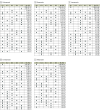Agreement of Different Drug-Drug Interaction Checkers for Proton Pump Inhibitors
- PMID: 38980677
- PMCID: PMC11234238
- DOI: 10.1001/jamanetworkopen.2024.19851
Agreement of Different Drug-Drug Interaction Checkers for Proton Pump Inhibitors
Abstract
Importance: Proton pump inhibitors (PPIs) are a widely prescribed class of drugs, potentially interacting with a large number of medicines, especially among older patients with multimorbidity and polypharmacy. Beyond summary of product characteristics (SPCs), interaction checkers (ICs) are routinely used tools to help clinicians in medication review interventions.
Objective: To assess the consistency of information on drugs potentially interacting with PPIs as reported in their SPCs and different ICs.
Design, setting, and participants: This cross-sectional study was conducted using data from SPCs for 5 PPIs (omeprazole, esomeprazole, lansoprazole, pantoprazole, and rabeprazole) and 5 ICs (ie, INTERCheck WEB, Micromedex, Lexicomp, Epocrates, and drugs.com). Information from the SPCs and the ICs were extracted between July 15 and 30, 2023.
Main outcomes and measures: The main outcome was the level of agreement among SPCs and the 5 ICs in identifying drugs potentially interacting with PPIs and attributing drug-drug interaction (DDI) severity categories. The level of agreement was computed using Gwet AC1 statistic on the 5 ICs and by comparing 4-sets and 2-sets of ICs. As a sensitivity analysis, the level of agreement in listing PPI-related DDIs was evaluated using Cohen κ and Fleiss κ coefficients.
Results: Considering SPCs and the 5 ICs, a total of 518 potentially interacting drugs with omeprazole were reported, 455 for esomeprazole, 433 for lansoprazole, 421 for pantoprazole, and 405 for rabeprazole. As compared with the ICs, the SPCs reported a much smaller number of drugs potentially interacting with PPIs, with proportions ranging from 2.7% (11 potentially interacting drugs) for rabeprazole to 7.6% (33 potentially interacting drugs) for lansoprazole of the total identified drugs at risk of interaction with a PPI. The overall level of agreement among the 5 ICs for identifying potential interactions was poor (from 0.23 [95% CI, 0.21-0.25] for omeprazole to 0.27 [95% CI, 0.24-0.29] for pantoprazole and 0.27 [95% CI, 0.25-0.29] for rabeprazole). Similarly, the level of agreement was low in 4-set and 2-set analyses as well as when restricting the analysis to the potential DDIs identified as severe (range, 0.30-0.32).
Conclusions and relevance: This cross-sectional study found significant disagreement among different ICs and SPCs, highlighting the need to focus on standardizing DDI databases. Therefore, to ensure evaluation and prevention of clinically relevant DDIs, it is recommended to revise multiple ICs and consult with specialists, such as clinical pharmacologists, particularly for patients with complex medical conditions.
Conflict of interest statement
Figures
Comment in
-
Navigating Drug Interactions with Proton Pump Inhibitors.JAMA Netw Open. 2024 Jul 1;7(7):e2419818. doi: 10.1001/jamanetworkopen.2024.19818. JAMA Netw Open. 2024. PMID: 38980682 No abstract available.
References
MeSH terms
Substances
LinkOut - more resources
Full Text Sources
Medical
Research Materials



